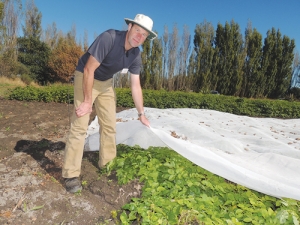Wired for Science: Understanding the feeding habits of mealybug
Fussy children might be frustrating, but fussy mealybugs could help protect the New Zealand wine industry from grapevine leafroll-associated virus 3.
 Physical barriers such as mesh may be an alternative to pesticides, but beware unintended consequences, says Charles Merfield of Lincoln’s BHU.
Physical barriers such as mesh may be an alternative to pesticides, but beware unintended consequences, says Charles Merfield of Lincoln’s BHU.
Do you know how docks, thistles and dandelions differ in their ability to regrow? Or from how deep particular weed species germinate? Or what are the alternative hosts for the pests that try to demolish your crops?
Finding answers to questions like these, before deciding how to tackle a problem, will make farm systems sustainable long-term, growers and agronomists attending a series of Foundation for Arable Research workshops are hearing.
Leading the workshops is Charles Merfield of Lincoln University’s biological husbandry unit (BHU). He says there’s been a “u-turn” in agricultural science and global agricultural policy since the 1980s, exemplified by 2015 being declared the Year of Soil by the United Nations.
“In the 1980s that would have been inconceivable… people would have asked ‘What are you on?’ ” he told the first of the FAR workshops.
The declaration reflects a “realisation at the top level” that healthy soil is essential to feed the world and important “for a whole lot of other issues”. Driving that realisation is a “considerable decline in soil health and quality around the world.”
Merfield says farmers’ interest in soil has always been greater than academics’ due to lack of funding for soil science, but economics have forced farmers to adopt practices detrimental to their dirt. “The huge problem here is nobody wants to pay you to [look after soil],” he points out.
However, that is starting to change in some parts of the world. “In the EU, most of what farmers get paid for now [in subsidies] is environmental protection, including looking after the soil.”
Here, regional council legislation increasingly requires soil protection onfarm to protect the wider environment but, legislation aside, it’s in farmers’ interest because soil is a property’s most valuable asset, says Merfield. Looked after, it improves productivity and reduces nutrient loss, he points out.
Organic matter is a driver of soil health and a “continuous, regular supply of freshly dead plant material and animal residues” should be the aim.
“Diversity is the spice of life,” adds Merfield, pointing out wheat straw year after year won’t work wonders, but a range of residues, weeds, composts and manures will.
The organic matter promotes biological activity which in turn makes nutrients available to plants. There’s little justification for inoculants. “Good quality research in this area is struggling to find any benefits.”
Typically soil biomass is about 10t/ha, in a “pretty stable ecosystem”, consequently inoculant quantities are minute by comparison and unlikely to have noticeable effect, he explains.
Relative quantity is also the key with foliar fertilisers. Applied in the right form, in the right way, to meet a correctly diagnosed need, they do work but they are “really, really expensive per kilogramme” of nutrient so should be used as an urgent fix rather than a long-term solution.
Moving onto the nutrients themselves, Merfield questions the concept of cation balance, often referred to as the Albrecht system, noting flaws in the original experiments and “very few” supportive field trials since. “Even the ones done by proponents of the system have often not found a result,” he points out.
He acknowledges many farmers adopting the system get positive results but suggests other causes, such as micronutrients in organic fertilisers used, or greater biological activity releasing already present nutrients, may be the reason why. “Inadvertently you may be correcting a deficiency.”
After nutrients, or lack of them, compaction is “the second biggest cause of yield loss” and it doesn’t require a big tractor to cause it, he warns. Even a Ferguson 35 squeezes soil pores below the plough layer, and “it’s the stuff at depth that is the hardest to see and to deal with,” he points out.
While there will be occasions where remedial action is required to give soil biology a helping hand to rectify compaction, avoiding compaction in the first place by controlling and minimising traffic should be the aim. Despite “huge” uptake already, there should be greater use of GPS and auto-steer technology.
Where fine seedbeds are required, such as for carrots or onions, reverse action tillers that create a tilth in one pass have merit. “Stuff like this has huge potential to reduce the number of passes and ‘oomph’ you put into the soil.”
But traditional rotary hoes or rotovators, particularly those with L-shaped blades, should be avoided. “If the devil invented a piece of tillage equipment, it would be the rotovator.”
The National Wild Goat Hunting Competition has removed 33,418 wild goats over the past three years.
New Zealand needs a new healthcare model to address rising rates of obesity in rural communities, with the current system leaving many patients unable to access effective treatment or long-term support, warn GPs.
Southland farmers are being urged to put safety first, following a spike in tip offs about risky handling of wind-damaged trees
Third-generation Ashburton dairy farmers TJ and Mark Stewart are no strangers to adapting and evolving.
When American retail giant Cosco came to audit Open Country Dairy’s new butter plant at the Waharoa site and give the green light to supply their American stores, they allowed themselves a week for the exercise.
Fonterra chair Peter McBride says the divestment of Mainland Group is their last significant asset sale and signals the end of structural changes.